Buying a shower enclosure for your bathroom or ensuite isn’t as simple as it may seem. There are several factors to take into account, such as size, style and even glass. In this buyer’s guide to shower enclosures, we outline all of the available options, so you can make the right choice for your very own bathroom.
CONTENTS:
- What is a shower enclosure?
- Which shower enclosure to buy?
- What must you consider when buying a shower enclosure?
- Which shower door to choose?
What is a shower enclosure?
First things first, you may be wondering what exactly a shower enclosure is? Sometimes also referred to as a shower cubicle, a shower enclosure is used to enclose your shower from the rest of your bathroom.
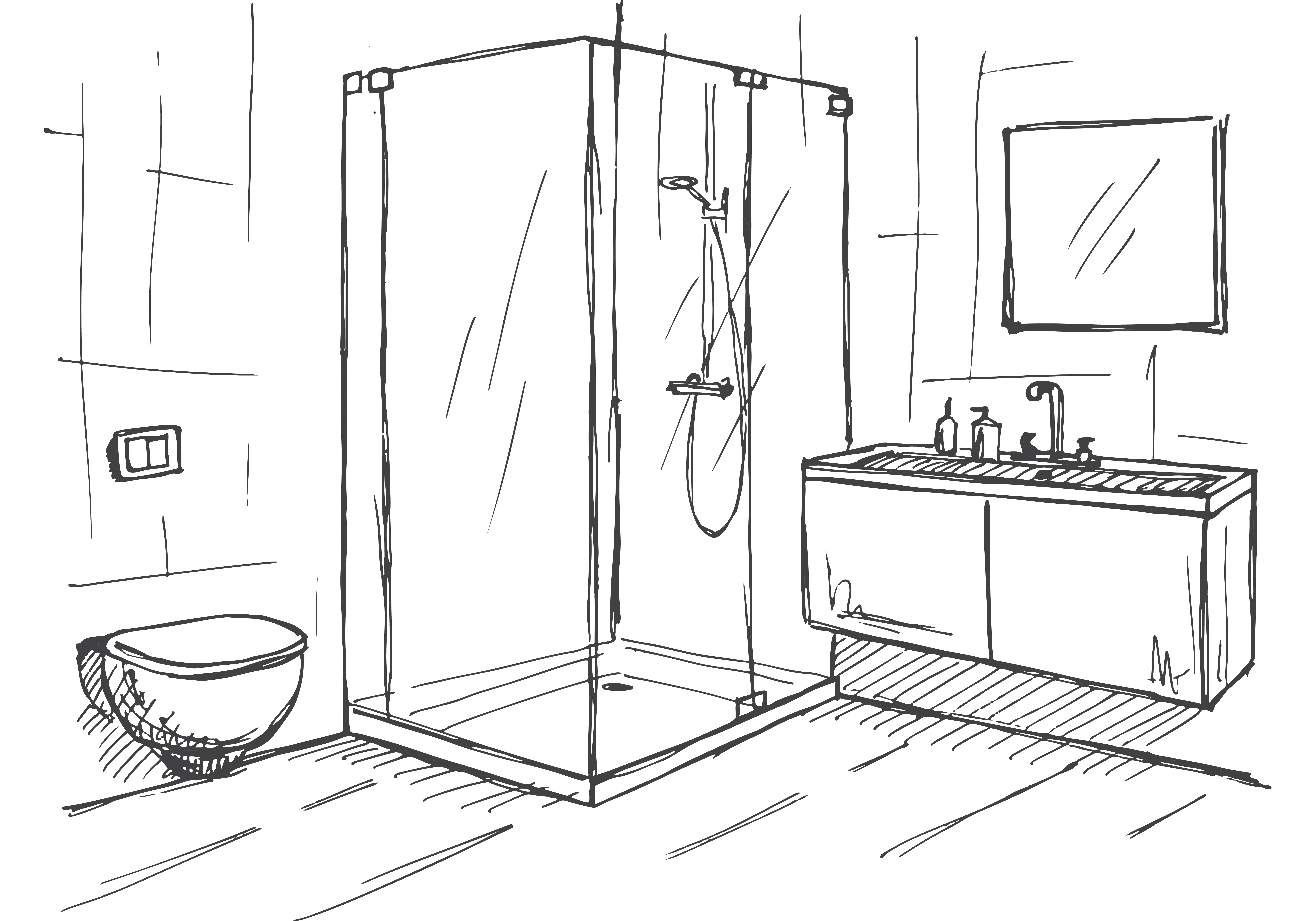
Photo credit: Arkadivna / Shutterstock
Shower enclosures come in all shapes and sizes, sometimes with or without a shower tray. More often than not, the most common shower size is approximately 800x800mm and 900x900mm.
Most of the time, shower enclosures come with one or more glass panels, as well as a door, which can either be a slide, pivot or fold-open design. A shower enclosure may even feature a walk-in design without a door too, forming a wet room.
Which shower enclosure to buy?
Deciding which shower enclosure to buy can be tough, especially when there are several different types of shower enclosure on the market, each with unique advantages for different bathrooms. However, the decision is entirely down to the configuration of your bathroom and what your personal preference is. Continue reading this shower enclosure guide to find out the main five things you must consider when buying a shower enclosure.
Top tip: Before buying a shower enclosure for your bathroom, it is advisable to sketch out the layout of your space and carefully think about everything you may need. Consider any plumbing work, whether you require a shaving port, and even which way your shower door should open: left or right?
What must you consider when buying a shower enclosure?
5. How to protect your walls from water
1. The space in your bathroom
Depending on the configuration of your bathroom – an ensuite, a main bathroom or separate shower room – it may influence the type of shower enclosure that you buy for your space.
However, with planning, it is entirely possible to fit a shower into a tight area and make life a little easier for you. For example, consider exactly how much room and height are available, as this may influence the decision you make. If you want to squeeze a shower into a tight spot, like a recess, it is advisable opt for a sliding or folding shower door.
2. The wall and positioning
Where is the best position for your shower enclosure to go? Will it be in the corner of the room, the centre of the wall, or in a separate enclosed area? It is important to think about this carefully, as this will impact on the type of shower tray and type of enclosure door you can purchase. For example, if you opt for a central position against a wall, you may require a “D” shape shower enclosure.
If you are replacing an old shower enclosure, it is advisable to keep your new shower in the same position. This will require a lot less plumbing work (as your drainage, cold and hot water pipes will already be in the correct place) and will help you to cut back on any additional costs for your new bathroom space.
3. The type of shower glass
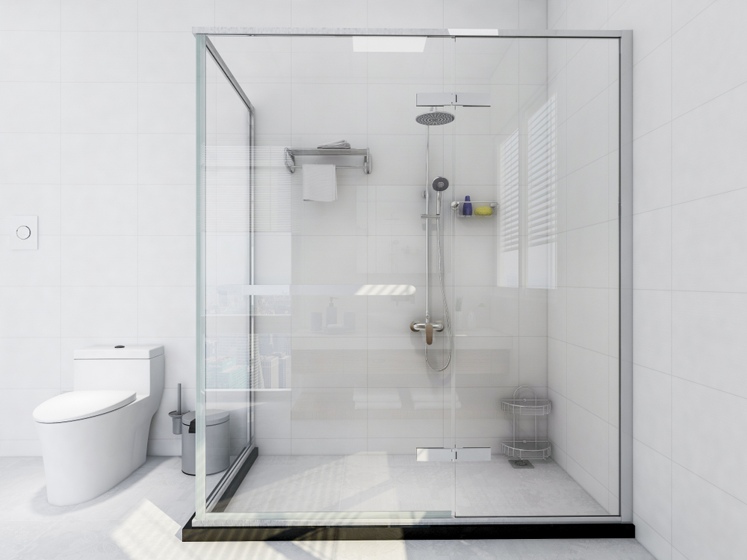
Photo credit: xujun / Shutterstock
The types of shower door that can be used for different shower enclosures vary significantly. At Showerstoyou.co.uk, we ensure that all of our products are of the highest quality, so you can be sure that whatever glass you choose for your shower enclosure will meet the highest possible safety standards.
Firstly, you must consider the thickness of the glass used in your shower enclosure. You can choose between four main thicknesses:
– 4mm: If you are looking for an inexpensive shower enclosure, or you don’t like the look of thicker glass, 4mm shower enclosures are a great option.
– 6mm: Similarly to 4mm, 6mm shower enclosures are fairly inexpensive and offer great quality and value for money.
– 8mm: 8mm shower enclosures are often considered “luxury” as they are manufactured using premium and high-quality materials.
– 10mm: “Premium” 10mm glass is perfect for use as wet room panels and shower enclosures.
When choosing glass, it is wise to search for shower enclosure glass with an easy clean coating, which helps to reduce the build-up of soap, grime and limescale. This often comes with tempered glass, which is highly durable, long-lasting and easy to clean.
Furthermore, always ensure that your glass shower enclosure comes with strong aluminium framing to support the glass and keep it protected, to avoid any chips or breakages from occurring. However, bear in mind that if you opt for thicker glass panels, your shower enclosure may need further support due to the extra weight.
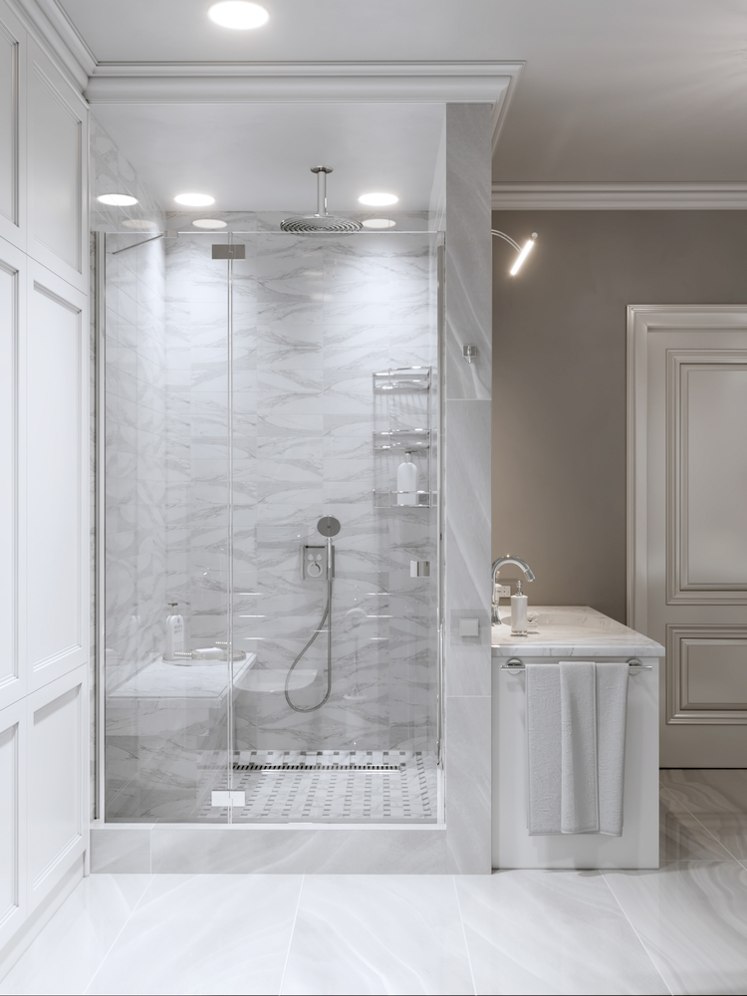
Photo credit: Svet_Feo / Shutterstock
4. The shower tray
If you are looking for an all-in-one solution, purchasing a shower tray with your enclosure is advisable, as the tray is designed specifically to fit that precise enclosure. This is often the case with walk-in shower enclosures which are complete with a matching tray to help with drainage.
Having an ill-fitting shower enclosure and tray can increase the chances of water leakage – the last thing you need when you have just fitted a new bathroom suite.
In addition, buying an enclosure and tray together means you don’t have to think about tray size and measuring the space yourself, which can be tricky. However, you will need to carefully consider the sizes of the tray and shower door when planning a recess shower, for instance.
5. Protect your walls from water
Remember, the interior walls of your shower enclosure will need protection from water, as this can be achieved using shower wall panels or tiles.
Shower wall panels are fast becoming a popular alternative to tiles and have a number of benefits:
- They’re quicker and easier to install – no grouting or shaping required
- They’re more cost-effective
- They’re easier to maintain
- They offer a seamless finish, with no joins visible
- They come in a wide range of colours and patterns, including stone and wood-effect designs, to suit your décor
Despite this, you may want to stick to tradition and opt for wall tiles instead, due to their stylish appearance and hardwearing nature.
It is important to bear in mind that all tiles must be properly tiled and sealed correctly, to avoid water getting in the walls. The same goes for when you are installing a wet room, as you will need to ensure all areas – including the floor and walls – are watertight. Alternatively, you may want to opt for a walk-in shower which reduces the amount of tiling for the floor area because you can use a shower tray instead.
What is the best shower enclosure to buy? These are our top picks
Which shower door to choose?
With showers becoming increasing popular today, more people are choosing to buy shower enclosures to create extra space in their bathrooms. But one of the key questions on homeowners’ lips is what type of shower door should you choose for your enclosure? Should you choose a sliding door that will maximise space, or create a style statement with a folding door? Our shower enclosure and shower door guide will help you find out which is right for you.
Pivot doors | Sliding doors | Bi-fold doors | Hinged doors | Wet room / Walk-in shower
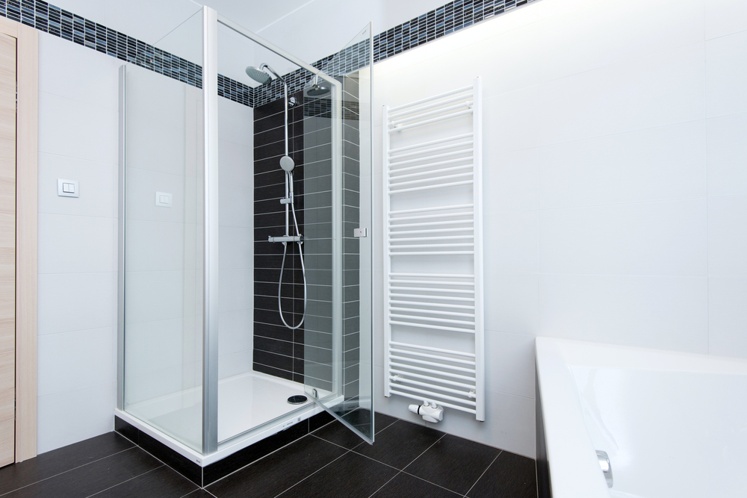
Photo credit: Ventura / Shutterstock
The simplest shower doors on the market are pivot doors. These are traditional open-shut shower doors, which can be configured to open outwards and inwards depending on your bathroom’s design.
Pivot bathroom doors are ideal for those who have slightly more space in their bathroom, as when closed they create lots of space, but once opened they can make a small room feel even more poky.
If you do choose a pivot shower door, bear in mind that outward opening doors can end up making the floor wet, so these doors work best in wet-room style bathrooms with clever non-slip flooring fitted.
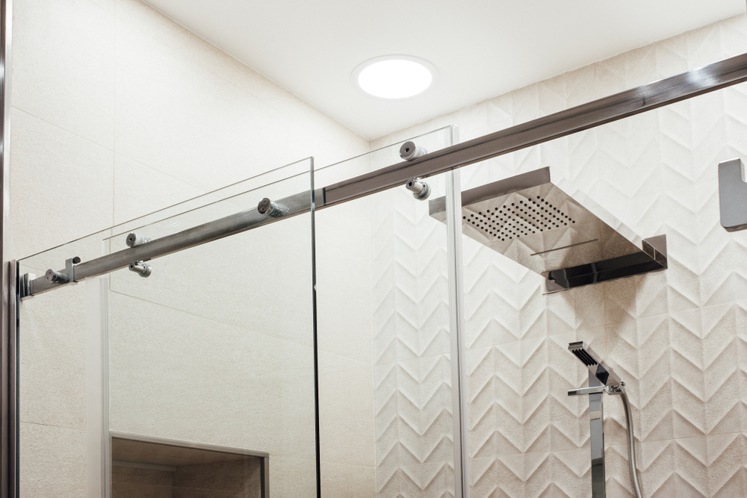
Photo credit: Katya Nikitina / Shutterstock
Sliding shower doors can help to save space in smaller bathrooms, as they ensure the whole shower enclosure remains compact – unlike an outward opening pivot door, for instance. This type of shower door is often found on contemporary models (such as the one pictured), as well as on quadrant shower enclosures which can be fitted into the corner of a bathroom to optimise space. As a result, this type of shower enclosure door is ideal for small guest bathrooms and cloakrooms in particular.
An added bonus is that these shower doors require no extra room in the bathroom. Thus, the extra space which is saved from no outward opening door can be used to create a more spacious shower cubicle too – a win-win.
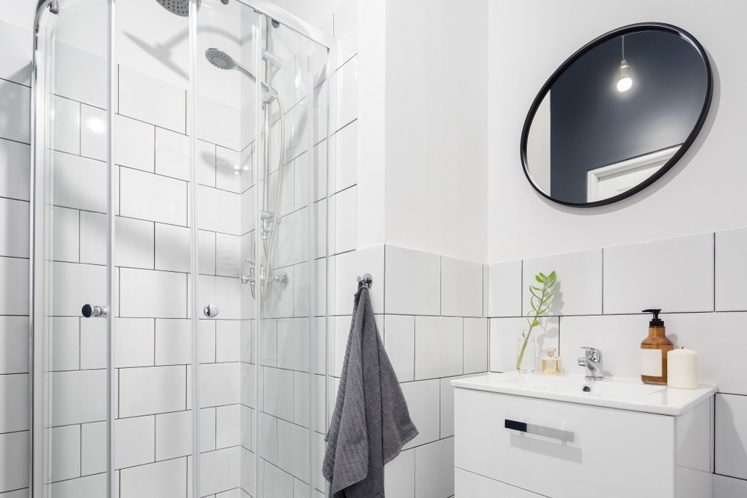
Photo credit: Dariusz Jarzabek / Shutterstock
Another option includes bi-fold doors, which can help to create a striking design statement, unlike a traditional open-close shower door. Not only does the angular design provide great functionality, it is perfect for a luxurious and modern-looking abode.
This type of shower enclosure door helps to make sure the shower is the focal point of the room, which is ideal if a shower is the most-used feature of the bathroom space. It’s also ideal if space is a premium, as bi-fold shower enclosure doors can be purchased with two, or even three, folds.
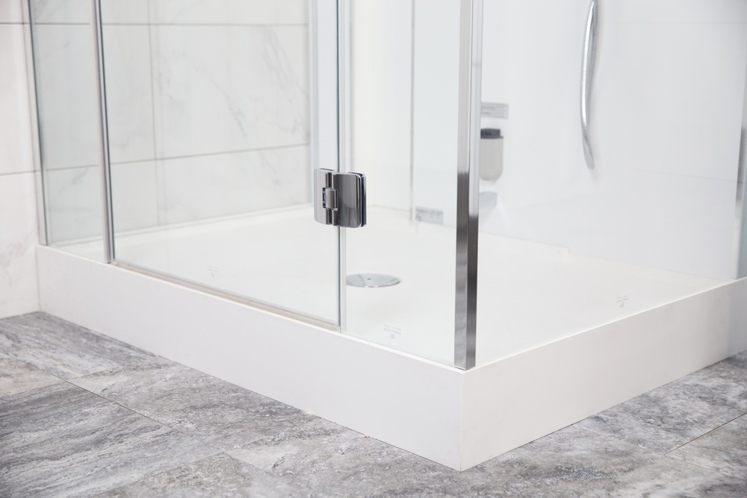
Photo credit: Retan / Shutterstock
Another simple style of shower door is hinged doors, as they simply open and shut like a traditional door. This type of design is suitable for both straight or curved shower enclosures and can be purchased to open on the left- or right-hand side.
This classic style of shower door is available in a several different styles, from contemporary to traditional, to suit all bathroom designs. This type of door is best suited for a large bathroom, as they open out into your bathroom space, requiring space around the enclosure for the door to extend.
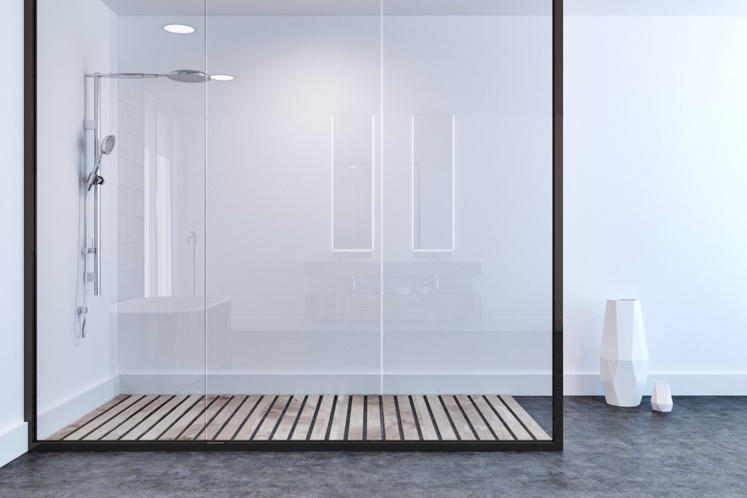
Photo credit: ImageFlow / Shutterstock
Alternatively, if none of the options above suit you, you may want to consider installing a wet room to benefit from a more spacious room with no doors. All you need is a walk-in shower enclosure, which is curated using glass panels to add structure, without taking up any unnecessary space in the room.
For a walk-in shower/wet room, all you need to do is install a shower head anywhere on a wall – et voila! You don’t need to worry about purchasing any kind of enclosure or protecting the rest of the room from flooding – apart from tiling the room to make it watertight and adding a drain, of course.
Feature image credit: Arkadivna / Shutterstock
